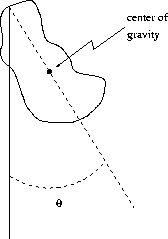




Next: Simple Pendulum:
Up: SIMPLE HARMONIC MOTION -
Previous: General Properties
Figure 9:
The Physical Pendulum
 |
 |
(21) |
where I is the moment of inertia of the pendulum, and the last expression is approximately true for small angular displacements  (rads) << 1
(rads) << 1
gabor@theory.uwinnipeg.ca
2001-01-05
